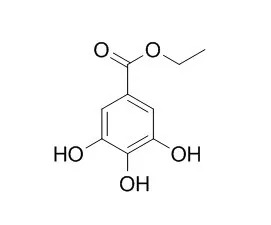| Kinase Assay: |
| Yao Xue Xue Bao. 2015 Jan;50(1):45-9. | | Effect of ethyl gallate on invasion abilities and its mechanism of breast cancer MDA-MB-231 cells.[Pubmed: 25924474] | This study is to investigate the effect of Ethyl gallate on invasion capabilities and its mechanism of breast cancer MDA-MB-231 cells.
METHODS AND RESULTS:
Using cell adhesion and transwell assay, separately, the effects of Ethyl gallate on the invasion of MDA-MB-231 cells were measured. The Akt-NF-κB signal pathway protein expressions were analyzed with Western blot. Also, the mRNA levels of MMP-9 and MMP-2 were analyzed by RT-PCR. Ethyl gallate inhibited the abilities of motility, adhesion and invasion of breast cancer MDA-MB-231 cells in vitro (P<0.05), inhibited the mRNA levels of MMP-9, MMP-2, phosphorylation of AKt and protein expression of NF-κB.
CONCLUSIONS:
It is concluded that Ethyl gallate can inhibit the abilities of invasion of breast cancer in vitro by inhibiting the mRNA levels of MMP-9/MMP-2, phosphorylation of Akt and protein expression of NF-κB. |
|
| Cell Research: |
| Nat Prod Res. 2015;29(4):366-9. | | In vitro evaluation of antiproliferative effect of ethyl gallate against human oral squamous carcinoma cell line KB.[Pubmed: 25104086 ] | Although some polyphenols are known to possess anticancer activity against different cancer cell lines through induction of apoptosis, the mode of antiproliferative effect of Ethyl gallate against human oral squamous carcinoma cell line KB was not studied until now. Therefore, the antiproliferative effect of Ethyl gallate was evaluated by 3-(4,5-dimethylthiazol-2-yl)-2,5-diphenyltetrazolium bromide assay in comparison with the reference drug paclitaxel.
METHODS AND RESULTS:
Generation of reactive oxygen species, mitochondrial membrane potential loss, DNA damage and apoptosis were determined using 2,7-diacetyldichlorofluorescein fluorescence, uptake of rhodamine-123 by mitochondria, comet assay and acridine orange/ethidium bromide dual-dye staining method. Both Ethyl gallate and paclitaxel exhibited cytotoxicity in a dose-dependent manner. The 50% inhibitory concentration for Ethyl gallate was 30 and 20 μg/mL for paclitaxel.
CONCLUSIONS:
A volume of 50 μg/mL of Ethyl gallate was found to be significantly effective (P < 0.05) in controlling the cancer cell proliferation leading to acute apoptosis. |
|
| Animal Research: |
| Crit Care Med. 2012 Feb;40(2):560-72. | | Benefits of ethyl gallate versus norepinephrine in the treatment of cardiovascular collapse in Pseudomonas aeruginosa septic shock in dogs.[Pubmed: 22020237] | Vasopressor therapy is required in septic shock to maintain tissue perfusion in the face of hypotension. Unfortunately, there are significant side effects of current vasopressors, and newer agents need to be developed. We recently discovered that Ethyl gallate, a nonflavonoid phenolic antioxidant found in food substances, could reverse low mean arterial pressure found in an experimental model of septic shock due to inhibition of hydrogen peroxide signaling. In the present study, we compared the hemodynamic and biochemical effects of Ethyl gallate vs. those of the commonly used vasopressor, norepinephrine, in a bacteremic canine model of Pseudomonas aeruginosa sepsis in two protocols.
METHODS AND RESULTS:
We performed these studies in anesthetized and mechanically ventilated dogs. In the early treatment protocol, we infused P. aeruginosa until mean arterial pressure first decreased to ~60 mm Hg (about 2-3 hrs), after which we stopped the infusion and randomly administered Ethyl gallate or norepinephrine in respective groups. In the late treatment protocol, we administered Ethyl gallate or norepinephrine after a sustained ~5-hr decrease in mean arterial pressure to 60 mm Hg and continued the infusion for the duration of the experiment. We followed parameters for over 10 hrs after the initiation of P. aeruginosa in both groups. We measured stroke work, urine output, serum creatinine, among other parameters, and used serum troponin T as an index of myocardial injury. We found that in both protocols, Ethyl gallate and norepinephrine improved mean arterial pressure and stroke work to similar extents over the duration of the study. Particularly in the late treatment protocol, Ethyl gallate resulted in a lower heart rate, a lower troponin T, and a greater urine output as compared with norepinephrine (p < .05).
CONCLUSIONS:
These results suggest that phenolic antioxidants, such as Ethyl gallate, that inhibit hydrogen peroxide signaling, may represent an alternative class of vasopressors for use in septic shock. |
|






 Cell. 2018 Jan 11;172(1-2):249-261.e12. doi: 10.1016/j.cell.2017.12.019.IF=36.216(2019)
Cell. 2018 Jan 11;172(1-2):249-261.e12. doi: 10.1016/j.cell.2017.12.019.IF=36.216(2019) Cell Metab. 2020 Mar 3;31(3):534-548.e5. doi: 10.1016/j.cmet.2020.01.002.IF=22.415(2019)
Cell Metab. 2020 Mar 3;31(3):534-548.e5. doi: 10.1016/j.cmet.2020.01.002.IF=22.415(2019) Mol Cell. 2017 Nov 16;68(4):673-685.e6. doi: 10.1016/j.molcel.2017.10.022.IF=14.548(2019)
Mol Cell. 2017 Nov 16;68(4):673-685.e6. doi: 10.1016/j.molcel.2017.10.022.IF=14.548(2019)